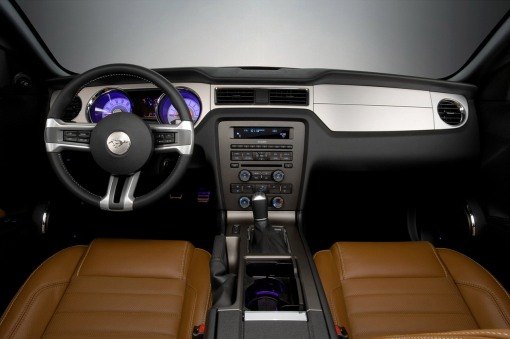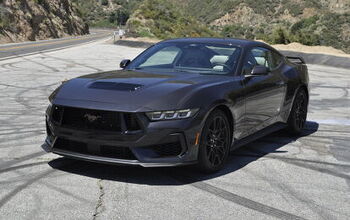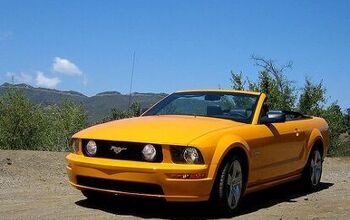Review: 2010 Mustang GT Convertible
Unless all the reviews you’ve read about the 2010 Ford Mustang appear in publications like Mustang Monthly, you probably know that the car is (a) an evolutionary improvement of the hold-over SN197 chassis and (b) still far from perfect. After a conflicting afternoon with a beautiful Red Candy Metallic 2010 Mustang GT Convertible [not pictured], I feel compelled to say something about how the Ford Mustang is currently situated in both the market and in our minds.
No doubt about it, Lee Iacocca had a great idea: building an all-new model on the inexpensive little 1960 Ford Falcon chassis, giving it Italian sports car styling cues and a galloping horse on the grille (in place of a prancing one), marketing it to the yet-to-be-catered-to Baby Boom generation – all completely brilliant. But as the market (and buyer demographics) changed, so did the Mustang’s place in it.
The first time I drove the completely redesigned 2005 model, I immediately knew that this pony was now (pun in 3…2…1…) “fording” much deeper water than ever before. Critics’ (and potential customers’) comparative statements no longer carried the distant echo of, “Wow, this car sure is a lot cooler than the Falcon.” Instead, they sounded like, “This car feels way cheaper and less refined than an Audi.”
And there’s the rub. Instead of riding fences, the Mustang now seems content to (conveniently) straddle them. Were the original formula still in place, today’s Mustang would be an el cheapo sport compact built atop a Focus platform, and everyone’s expectations would be much, much lower. As it is, the car seems to be aiming for a target that it can’t – at its current price point – profitably reach. But that depends on who you ask.
Ask my wife Becky (proud owner of a Candy Apple Red ’68 Mustang convertible…and my co-driver for the afternoon), and she’ll simply say that the new ‘Stang we drove was beautiful. And it was. The slightly dark red metallic paint contrasted beautifully with the saddle interior and 19-inch gray, five-spoke rims. Even though I don’t like the 2010 styling refresh, I still loved it (in the same way you love the looks of a perfectly preserved or restored example of a car you thought was ugly 20 years ago).
Good looks only carry a vehicle so far; once inside, you’ll immediately notice that functionality remains style’s jailhouse punk. Compared to the ’05-’09 Mustang, you’ll find even harder to decipher (but more retro than ever!) instrument faces, more restrictive (but now flip-up-door-covered!) cup holders, and an inexplicably taller (but soft to the touch!) automatic transmission shifter that obstructs climate controls more than before. Those opting for the manual transmission won’t be bothered by this last nuisance, and happily, the revised console storage bin now includes an integral lid that you won’t bump your elbow against while shifting. Unfortunately, the space inside is more awkwardly shaped (and seems smaller) than the departing binnacle – a big deal when you have to live every day with a car not known for its interior storage capacity.
One thing Mustangs are known for, though, is performance. And with more power than its predecessor, this horse seemed poised to run faster than any run-of-the-glue-factory GT ever has. Except that it didn’t. Maybe the car I drove was down on power, but after turning “off” the traction control and brake-torquing it as much as I could (to 2,300 RPM, which was as much as the brakes on my tester could hold – crazy, I know), I floored it, reeling off several tire-chirping (but not tire-spinning) sprints to sixty that – though untimed – registered as far, far slower on the seat-of-the-pants scale than the 2009 California Special I drove last year. The sonorous (thanks, engine-noise tube) 4.6-liter V8 sounded fine, and the 5R55S automatic transmission snicked off reasonably quick shifts. But even considering the tallish standard 3.31:1 final drive ratio (3.55’s and 3.73’s are optional), the acceleration was flatly disappointing.
Of course there’s more to performance than straight-line rocket-sleddery (even if the Mustang’s reputation doesn’t include much of it), and I thankfully got the chance to do the solid-axle shuffle on some decently twisty local blacktop. Overall, the chassis seemed well-balanced for its purpose. Hardcore horsepower hooligans may find it lacking after modding up more muscle from their Mustang’s modular mills (if not avidly avoiding alliteration), but as a complete package, the car’s handling capability nicely complements its stock 315 horsepower and is relatively benign as the beefy tires bite hard in corners, cooperating nicely with the much-improved steering feedback to inspire a lot more curved-road confidence than the outgoing model. Added bonus: It has a softer, quieter ride now, too. Just make sure you hit pot holes with both rear wheels.
I guess it’s fair to say that my impression of the 2010 Mustang GT Convertible and my opinion of the car are slightly different. My impression: After a fun afternoon in a beautiful drop-top, I found myself seriously disillusioned with the performance and ergonomics, but generally satisfied with everything else. My opinion: This pony is capable of playing in some rather uppity pastures, even if just barely. Still, judged in such company (A4, 3-Series, etc.), it will usually finish dead last. Compared to any previous Mustang, the 2010 is hands-down the best of the breed. But compared to other similarly-priced convertibles, it’s more of a dog.
Take it from this horse’s mouth: Ford employs some world-class bean counters, and they’ve done a swell job of assigning a plausible monetary value to nostalgia and the appeal of an iconic American image – a value that increases the Mustang GT’s price well above its true worth as a performance car. Synergy, perhaps? Uh, they only wish. For me, the bottom line is this: There are at least 40 other types of Mustangs that I’d rather spend $40,000 on.
More by Don Gammill Jr.
Latest Car Reviews
Read moreLatest Product Reviews
Read moreRecent Comments
- Corey Lewis It's not competitive against others in the class, as my review discussed. https://www.thetruthaboutcars.com/cars/chevrolet/rental-review-the-2023-chevrolet-malibu-last-domestic-midsize-standing-44502760
- Turbo Is Black Magic My wife had one of these back in 06, did a ton of work to it… supercharger, full exhaust, full suspension.. it was a blast to drive even though it was still hilariously slow. Great for drive in nights, open the hatch fold the seats flat and just relax.Also this thing is a great example of how far we have come in crash safety even since just 2005… go look at these old crash tests now and I cringe at what a modern electric tank would do to this thing.
- MaintenanceCosts Whenever the topic of the xB comes up…Me: "The style is fun. The combination of the box shape and the aggressive detailing is very JDM."Wife: "Those are ghetto."Me: "They're smaller than a Corolla outside and have the space of a RAV4 inside."Wife: "Those are ghetto."Me: "They're kind of fun to drive with a stick."Wife: "Those are ghetto."It's one of a few cars (including its fellow box, the Ford Flex) on which we will just never see eye to eye.
- Oberkanone The alternative is a more expensive SUV. Yes, it will be missed.
- Ajla I did like this one.





































Comments
Join the conversation
I don't think you can compare the 3 series and the Mustangs, they're just too different. Their purpose is also different. The problem with the Mustang is that it's playing with a price point where there are offerings that have more performance, luxury and quality. Seriously 40K plus........for a Mustang!? Id just save a bit more and get an LT1 trimmed Vette or a G37S, I just don't see the value on this car.
I have to say guys that I enjoyed the 2010 Mustang Convertible Review and subsequent comments so much, that I joined up just to Post a 'Thank You' for a real fun read! Cheers,